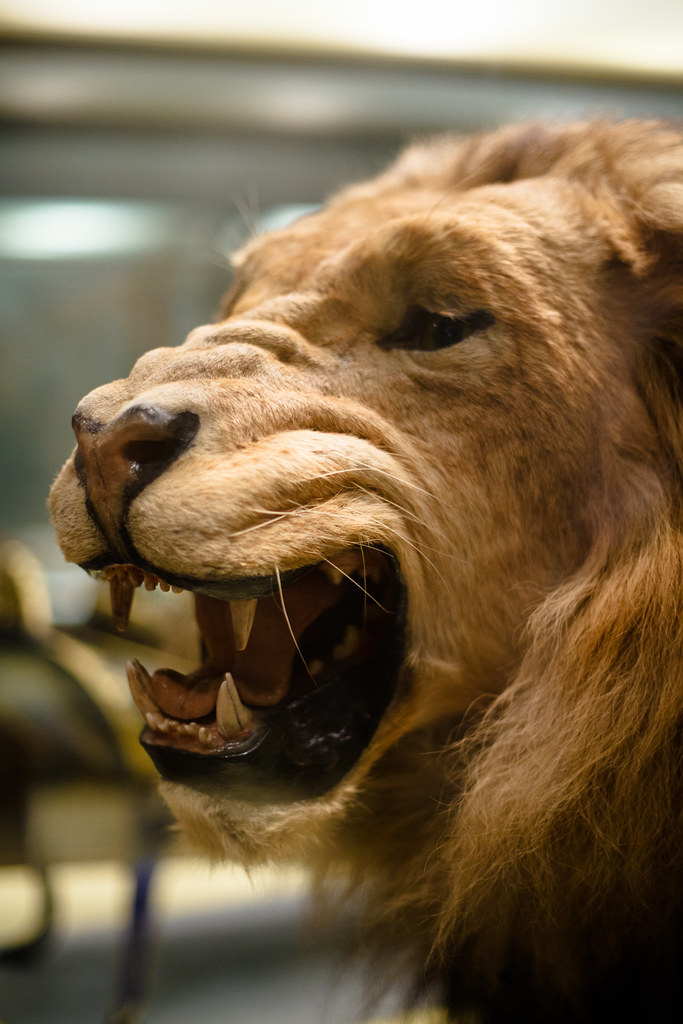The Tsavo Man-Eaters were a pair of notorious man-eating Tsavo lions responsible for the deaths of a number of construction workers on the Kenya-Uganda Railway from March through December 1898.

History
In March 1898 the British started building a railway bridge over the Tsavo River in Kenya. The project was led by Lt. Col. John Henry Patterson. During the next nine months of construction, two maneless male Tsavo lions stalked the campsite, dragging Indian workers from their tents at night and devouring them. Crews tried to scare off the lions and built campfires and bomas, or thorn fences, around their camp for protection to keep the man-eaters out, to no avail; the lions leaped over or crawled through the thorn fences. After the new attacks, hundreds of workers fled from Tsavo, halting construction on the bridge. Patterson set traps and tried several times to ambush the lions at night from a tree. After repeated unsuccessful attempts, he shot the first lion on 9 December 1898. Twenty days later, the second lion was found and killed. The first lion killed measured nine feet, eight inches from nose to tip of tail. It took eight men to carry the carcass back to camp. The construction crew returned and finished the bridge in February 1899. The exact number of people killed by the lions is unclear. Patterson gave several figures, overall claiming that there were 135 victims.
Patterson writes in his account that he wounded the first lion with one bullet from a high caliber rifle. This shot struck the lion in its back leg, but it escaped. Later, it returned at night and began stalking Patterson as he tried to hunt it. He shot it through the shoulder, penetrating its heart with a more powerful rifle and found it lying dead the next morning not far from his platform. The second lion was shot at most nine times, five with the same rifle, three with a third and once with a forth rifle.
The first was fired from atop a scaffolding Patterson had built near goat kills done by the lion. Two, both from the second rifle were shot into it eleven days later as the lion was stalking Patterson and trying to flee. When they had found the lion the next day thereafter, Patterson shot it three more times with the same rifle, severely crippling it, and shot it three times with the third rifle, twice in the chest, and once in the head, which killed it. He claimed it died gnawing on a fallen tree branch, still trying to reach him.
After 25 years as Patterson's floor rugs, the lions' skins were sold to the Chicago Field Museum in 1924 for a sum of $5,000. The lions' skins came at the museum in very poor condition. The lions were then reconstructed and are now on permanent display along with the original skulls.
Lions In Chicago Museum Video
Modern research
The two lion specimens in Chicago's Field Museum are known as FMNH 23970 (killed 9 December 1898) and FMNH 23969 (killed 29 December 1898). Recent studies have been made upon the isotopic signature analysis of ?13C and Nitrogen-15 in their bone collagen and hair keratin and published in the Proceedings of the National Academy of Sciences USA. Using realistic assumptions on the consumable tissue per victim, lion energetic needs, and their assimilation efficiencies, researchers compared the man-eaters' ?13C signatures to various reference standards: Tsavo lions with normal (wildlife) diets, grazers and browsers from Tsavo East and Tsavo West, and the skeletal remains of Taita people from the early 20th century. This analysis estimated that FMNH 23969 ate the equivalent of 10.5 humans and that FMNH 23970 ate 24.2 humans.
This leads to the conclusion that the lower number of 35 victims is more likely and confirms the study published 8 years previously by Julian Kerbis Peterhans and Thomas Patrick Gnoske (2001) who estimated 28-31 victims. It appears that Colonel Patterson exaggerated his claims as have subsequent investigators (e.g. "135 men", Neiburger and Patterson, 2000) (though none of these modern studies have taken into account the people who were killed but not eaten by the animals). The diet of the victims would also affect their isotopic signature. A low meat diet would produce a signature more typical of herbivores in the victims, affecting the outcome of the test. This research also excludes, but does not disprove, the claims that the lions were not eating the victims they killed but merely killing just to kill. Similar claims have been made of other wildlife predators.
The earlier (2001) study by Tom Patrick Gnoske and Julian Kerbis Peterhans, published in the Journal of the East African Natural History Society, contended that the proposed human toll of 100 or more was most likely an exaggeration and that the more likely total was 28-31 victims. This reduced total was based on their review of Colonel Patterson's original journal, courtesy of Alan Patterson (grandson of the Colonel, the Bodleian Library at Oxford University and Colonel Patterson's original publication (1907)). This 2001 study systematically reviewed causes of man-eating behavior among lions with particular attention to the Man-Eaters of Tsavo.

Possible causes of "man-eating" behavior
Theories for the "man-eating behavior" of lions have been reviewed by Kerbis Peterhans and Gnoske (2001) and Bruce Patterson (2004). Their discussions include the following:
- An outbreak of rinderpest disease (cattle plague) in 1898 devastated the lions' usual prey, forcing them to find alternative food sources.
- The Tsavo lions may have been accustomed to finding dead humans at the Tsavo River crossing. Slave caravans bound for Zanzibar routinely crossed the river there.
- "Ritual invitation", or abbreviated cremation of Hindu railroad workers, invited scavenging by the lions.
An alternative argument indicates that the first lion had a severely damaged tooth that would have compromised its ability to kill natural prey. Evidence for this is presented in a series of peer-reviewed papers by Neiburger and Patterson (2000, 2001, 2002) and in Bruce Patterson's (2004) book. This theory has been generally disregarded by the general public and Lieutenant-colonel Patterson, who killed the lions, personally disclaimed it, saying that he damaged that tooth with his rifle while the lion charged him one night, prompting it to flee.

Popular culture
In film
Patterson's book was the basis for several movies:
- A monochrome, British film of the 1950s
- Bwana Devil (1952)
- The Ghost and the Darkness a 1996 film in which Val Kilmer plays the daring engineer who hunts down the lions of Tsavo
- Prey (2007)
The incidents were also used in Killers of Kilimanjaro (1959).
In games
- The lions appear as a difficulty to be overcome in the "Cape to Cairo" scenario of the video game Railroad Tycoon II.
- Tsavo'ka (translation: Ghost in the Darkness) is a rare tiger that can be found on the Timeless Isle in World of Warcraft.
- In Cabela's Dangerous Hunts 2011 the lions were mentioned by the character Mbeki to the main character Cole as he was telling him about mysterious animals that have been terrorizing local villages.
In print
- Ghosts of Tsavo: Stalking the Mystery Lions of East Africa (2002) by Philip Caputo
- The Lions of Tsavo: Exploring the Legacy of Africa's Notorious Man-Eaters (2004) by Field Museum of Natural History scientist Bruce Patterson
- The plot of the Willard Price book Lion Adventure (1967) was inspired by the man-eaters of Tsavo, wherein Hal and Roger Hunt are hired to deal with a man-eating lion that's preying on railroad workers. At one point in the book, Hal recounts Colonel Patterson's original tale.
- The story of Patterson and the man-eating lions was also an inspiration for the book Three Weeks in December (2012) by Audrey Schulman.
Are You Looking for Products
Here some products related to "Tsavo Man-Eaters".
Michael P. Wood: Books, B..
DK Eyewitness Travel Guid..
The Man-Eating Lions of T..
Animal Drawing: Anatomy a..
Get these at Amazon.com* amzn.to is official short URL for Amazon.com, provided by Bitly
Source of the article : here






EmoticonEmoticon